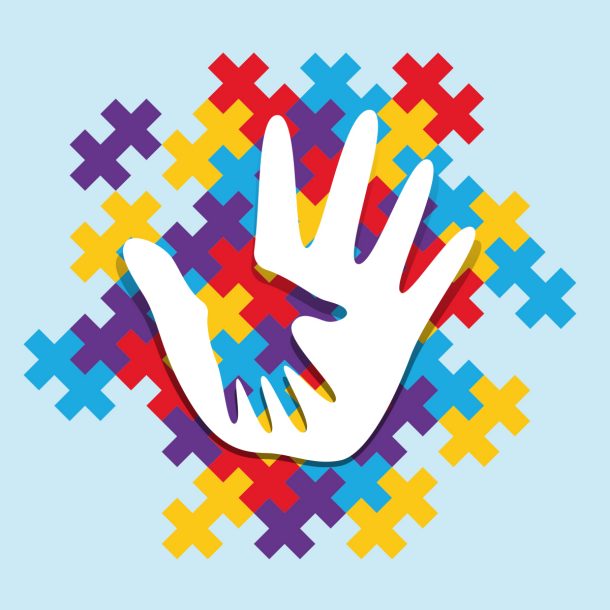-
Schaden & Unfall
Schaden & Unfall ÜberblickRückversicherungslösungenTrending Topic

Schaden & Unfall
Wir bieten eine umfassende Palette von Rückversicherungslösungen verbunden mit der Expertise eines kompetenten Underwritingteams.
-
Leben & Kranken
Leben & Kranken ÜberblickUnsere AngeboteUnderwritingTraining & Events

Leben & Kranken
Wir bieten eine umfassende Palette von Rückversicherungsprodukten und das Fachwissen unseres qualifizierten Rückversicherungsteams.
-
Unsere Expertise
Unsere Expertise ÜberblickUnsere Expertise

Knowledge Center
Unser globales Expertenteam teilt hier sein Wissen zu aktuellen Themen der Versicherungsbranche.
-
Über uns
Über uns ÜberblickCorporate InformationESG bei der Gen Re

Über uns
Die Gen Re unterstützt Versicherungsunternehmen mit maßgeschneiderten Rückversicherungslösungen in den Bereichen Leben & Kranken und Schaden & Unfall.
- Careers Careers
Showing Support by Understanding Autism and Its Impacts

2. April 2024
Benedict Tan,
Gary Wong
English
Raising Awareness for Autism Spectrum Disorder
Autism Spectrum Disorder (ASD) has been gaining attention within the scientific community and among the general public due to its complex nature and the remarkable range of abilities and challenges experienced by those it affects. Understanding ASD is crucial not only for diagnosed individuals and their families but also for society at large, as understanding opens avenues for support, acceptance, and inclusion.
Impact of ASD
Many individuals with ASD lead fulfilling lives, but for some, the disorder can be debilitating, especially if unaddressed. This is particularly true for those with severe symptoms such as profound communication difficulties, intellectual disability, or co‑occurring mental health conditions like anxiety or depression.1 Some of the potential challenges they or those close to them may face include:
Social and Communication Challenges
Significant challenges in social interactions and communication. Which might lead to social isolation and difficulties forming relationships2.
Behavioural and Emotional Impacts
Experience significant distress if they cannot engage in or are disrupted from their repetitive behaviours or specific routines. Sensory sensitivities with certain sounds, lights, or textures causing discomfort or even pain3.
Educational Challenges
Difficulty learning and, therefore, more likely to require specialized educational strategies to support their learning and development4.
Family Impacts
Parents and siblings may face stress from managing ASD-related challenges, navigating healthcare and educational systems, and providing support and care5.
Comorbidities
Other disorders that might be aggravated and surface as more serious conditions much later. These could be developmental disorders, psychiatric disease, and neurological diseases, which could include ADHD, GI disorder, anxiety disorder, behavioural issues, and risks of unhealthy BMI6.
How is ASD Diagnosed?
In recent years there has been a shift in how autism is defined in Diagnostic and Statistical Manual of Mental Disorders (DSM). DSM V, the most recent edition of the manual, classifies Autism, Rett’s Syndrome, Aspergers, and a few other disorders into a single diagnosis: autism spectrum disorder (ASD).7 The change from how these disorders were classified in DSM IV results from an evolving understanding that ASD is not a set of disconnected disorders, but rather it encompasses a spectrum with a wide range of symptoms and severity levels.
Diagnostic criteria for ASD consider two core domains: social communication / interaction and restricted / repetitive behaviours. The level of severity expressed will determine the diagnosis; that is, healthcare professionals make diagnoses according to the severity of each symptom.8 For example, children at Level 3 typically require intensive daily support with a multidisciplinary team.9 Guardians working alongside allied health professionals will be in the best position to assess the types of support needed.
|
DSM IV |
DSM V |
|
|---|---|---|
|
Satisfy 6 of 12 criteria, with at least 2 in each category:
|
Satisfy 3 criteria in A plus 2 out of 4 criteria in B:
|
Level 1 Requiring support |
|
Level 2 Requiring substantial support |
||
|
Level 3 Requiring very substantial support |
||
Figures in brackets represent the number criteria in the specific categories
Challenges in Diagnosis
One major challenge in diagnosing ASD is the variability in how symptoms present across different individuals and the level of attentiveness needed to notice such differences. The recent classification changes in DSM V means that some individuals who might have been diagnosed under separate categories in DSM IV might not meet the broader, unified criteria for ASD in DSM V.10 Although the shift aims to ensure more accurate and consistent diagnoses, the reclassification may exclude some milder cases that previously qualified, especially those with high functioning autism or Aspergers.11
Figure 1 – Autism Incidence Rate (Gen Re Dread Disease Survey 1519 – Hong Kong)

Based on definitions in critical illness products set out by insurers, we were able to identify a significant difference in incidence rates between DSM IV and DSM V, specifically at severity level 3. The need to fulfil all seven qualitative requirements across two categories might have led to the differences that we observed.
Understanding the Incidence of ASD
While prevalence of ASD has been reported to vary significantly across different markets, guidance by the World Health Organisation (WHO) shows that 1 in 100 children worldwide has autism.12 Currently no unified body publishes comparative statistics, and some countries might not have official statistics. These issues reflect lack of awareness as well as possible differences in diagnostic criteria and access to services.
Additionally, ASD is a condition that affects males more frequently than females, a 2009 study conducting a meta-analysis of research13 showed that the male-to-female ratio for Autism is 4:1. This disparity was also observed in our 8th edition of the Dread Disease Survey (DDS 1519), a ratio of 6:1. Despite statistical findings that ASD affects males more frequently than females, it is critical to avoid gender biases and stereotypes that portray ASD as a male-only disorder as this could hinder diagnosis in females.14 A factor contributing to the difference in ratio is that symptoms tend to be less pronounced15 in females and thus less noticeable. Females tend to mask their social deficits in a process known as “camouflaging”, the act of adopting learned behaviours so that they do not appear autistic in social settings. Examples could include mirroring expressions, forcing themselves to make eye contact, or stopping themselves from talking about their interests.
Gender differences aside, when looking at age-specific statistics, we also observed that the peak incidence rate occurs in juveniles aged 2‑3 years old with Autism at severity level 3, which is consistent with what we see in population incidence rates regarding the age of diagnosis.16
Treatment Options & Important Factors for Better Outcomes
Some of the possible treatments are:17

Behaviour and Communication Therapy

Educational Therapy

Family Therapy

Speech Therapy

Occupational and Physical Therapy

Medications to Control Symptoms
This treatment list is not exhaustive, and some treatments may be more effective than others. It is best to consult with the respective healthcare providers to adequately provide for the needs of individuals suffering from ASD.

Cognitive Ability

Treatment Age

Quality of Treatment

Treatment Intensity

Consistency
The best prognosis for a diagnosed child would be to start as early as possible and adjust treatments according to the child’s level of cognitive ability. Further, personalisation of a treatment plan and appropriate treatment intensity will help optimise the child’s learning progress. Lastly, consistency among the different treatments is extremely important. The child in treatment would likely value predictability, and receiving mixed signals might risk setbacks in the treatment progression.18
Potential Financial Impact of ASD
ASD profoundly affects not just the individuals diagnosed; it also affects their families and society at large. Its impacts are varied due to the wide range of symptoms and severity levels that characterize the spectrum. Insurance can help alleviate the economic burden of ASD, which can be substantial for families. In DDS 1519, the average sum assured for autism was HKD 130,000. In comparison, the U.S.‑based the Autism Developmental Disabilities Monitoring (ADDM) network reported that Early Intensive Behavioural Intervention (EIBI) can be costly, ranging from USD 40,000 to USD 60,000 each year.19 In Singapore, a parent who had gone through the process of getting her child into Early Intervention Programme for Infants and Children (EIPIC) reportedly incurred costs of up to SGD 39,00020 before subsidies or insurance. In Malaysia, a study21 conducted on the economic cost of early intervention for children with ASD placed the figure at MYR 15,000 for Early Intervention Program (EIP). Lastly, a parent in Hong Kong interviewed by the media22 stated that her child’s treatment could be up to HKD 8,000 per month. These examples only indicate the intervention costs for the child; in addition to these, there could be other related healthcare costs, educational expenses, and the costs of lost productivity for their caregivers.23
Our Underwriting Approach on ASD
Insurance companies may be concerned about the potentially higher loss ratio when covering children with ASD. Consider the U.S., for example: most states have mandated commercial insurers to pay for behavioural treatment for ASD, yet based on a study done in 2016, the impact is minimal.24 In Hong Kong, most participants in DDS 1519 had at least 1 product that covering ASD, and there was a total of 62 products offering such coverage. This is encouraging, as it demonstrates awareness of ASD and insurers’ recognition of the need for protection and support for individuals and their families who suffer hardships from the disorder.
At Gen Re, we underwrite and assess insurability with an open mind and consider multiple risk factors, including a comprehensive evaluation of the proposed insured’s level of severity, comorbidities (if any), and level of treatment received before we conclude with our underwriting decision.
Information on Resources and Support
Support and resources for individuals with ASD and their families vary by region but generally include educational programs, therapeutic interventions, and community support groups. Insurance coverage for ASD-related services has improved with greater recognition of ASD but remains inconsistent. At Gen Re, we feel that advocacy is crucial for expanding access to resources and support. Below are some helpful resources.
Hong Kong
ASD Partnership
https://ASDpartnership.com.hk/
Malaysia
ASD Link Malaysia
https://www.ASD.my
Singapore
ASD Resource Centre
https://www.ASD.org.sg
Gen Re is not affiliated nor works with any of these services
Understanding and supporting ASD is a collective responsibility. We all can contribute to a more inclusive society by learning about ASD, recognizing the challenges faced by those on the spectrum, and advocating for policies and practices that support individuals with ASD and their families. Whether through volunteering, education, fostering inclusive environments, or designing products to help individuals with ASD, every effort counts towards building a society that values and supports all its members.
- Simonoff, E., Pickles, A., Charman, T., Chandler, S., Loucas, T., & Baird, G. (2008). Psychiatric disorders in children with ASD spectrum disorders: Prevalence, comorbidity, and associated factors in a population-derived sample. Journal of the American Academy of Child & Adolescent Psychiatry, 47(8), 921‑929.
- American Psychiatric Association. (2013). Diagnostic and Statistical Manual of Mental Disorders (5th ed.).
- Lord, C., & Bishop, S. L. (2010). Austism Spectrum Disorders: Diagnosis, Prevalence, and Services for Children and Families. Social Policy Report, 24(2), 1‑21. https://eric.ed.gov/?id=ED509747.
- National Research Council. (2001). Educating Children with ASD. Washington, DC: National Academy Press. https://nap.nationalacademies.org/catalog/10017/educating-children-with-autism.
- Karst, J. S., & Van Hecke, A. V. (2012). Parent and family impact of Austism spectrum disorders: a review and proposed model for intervention evaluation. Clinical Child and Family Psychology Review, 15(3), 247‑277. https://pubmed.ncbi.nlm.nih.gov/22869324/.
- Hodges, H., Fealko, C., Soares, N. Autism spectrum disorder: definition, epidemiology, causes, and clinical evaluation. Transl Pediatr. 2020 Feb;9(Suppl 1):S55‑S65. doi: 10.21037/tp.2019.09.09. https://pubmed.ncbi.nlm.nih.gov/32206584/.
- American Psychiatric Association. Diagnostic and statistical manual of mental disorders. 5th ed. Arlington, VA: American Psychiatric Association; 2013.
- Center for Disease Control. Autism Spectrum Disorder (ASD) Diagnostic Criteria. https://www.cdc.gov/ncbddd/ASD/hcp-dsm.html.
- Understanding the Levels of Autism: What are the Three Levels of Autism? Mosaic Early Intervention. https://mosaicearlyintervention.com.au/levels-of-ASD/.
- Hartley-McAndrew, M., Mertz, J., Hoffman, M., et al. Rates of Autism Spectrum Disorder Diagnosis Under the DSM‑5 Criteria Compared to DSM‑IV‑TR Criteria in a Hospital-Based Clinic. Pediatr Neurol 2016;57:34‑8. 10.1016/j.pediatrneurol.2016.01.012. https://pubmed.ncbi.nlm.nih.gov/26869267/.
- Lai, MC., Lombardo, M.V., Chakrabarti, B., et al. Subgrouping the Autism "Spectrum": Reflections on DSM‑5. PLoS Biol 2013;11:e1001544. 10.1371/journal.pbio.1001544. https://journals.plos.org/plosbiology/article/citation?id=10.1371/journal.pbio.1001544.
- Autism Facts Sheet. World Health Organization. https://www.who.int/news-room/fact-sheets/detail/autism-spectrum-disorders
- Fombonne, E. Epidemiology of Pervasive Developmental Disorders. Pediatric Research. 2009;65:591‑598. https://doi.org/10.1203/PDR.0b013e31819e7203.
- Bargiela, S., Steward, R., Mandy, W. The Experiences of Late-Diagnosed Women with Autism Spectrum Conditions: An Investigation of the Female Autism Phenotype. J Autism Dev Discord 2016; 46(10):3281‑94. https://pubmed.ncbi.nlm.nih.gov/27457364/.
- Volkmar F., Siegel M., Woodbury-Smith M., et al. Practice parameter for the assessment and treatment of children and adolescents with autism spectrum disorder. J Am Acad Child Adolesc Psychiatry 2014; 53:237‑57. 10.1016/j.jaac.2013.10.013. https://pubmed.ncbi.nlm.nih.gov/24472258/.
- Lam, C. Autism Spectrum Disorder: A Brief Review. Child Assessment Service Epidemiology and Research Bulletin. 17: May 2020. https://www.dhcas.gov.hk/file/caser/CASER17.pdf.
- Autism spectrum disorder. Mayo Clinic. https://www.mayoclinic.org/diseases-conditions/ASD-spectrum-disorder/diagnosis-treatment/drc-20352934.
- Prognosis of Autism Spectrum Disorder. Autism Partnership. https://ASDpartnership.com.hk/en/prognosis-of-ASD-spectrum-disorder/
- Community Report From the Autism and Developmental Disabilities Monitoring (ADDM) Network. https://www.cdc.gov/ncbddd/autism/documents/addm-2012-community-report.pdf
- Autism In Singapore: How Much Can Parents Expect To Spend On Their Autistic Child During Preschooling Years. 14 May 2018. https://dollarsandsense.sg/ASD-singapore-much-can-parents-expect-spend-autistic-child-preschooling-years/
- Najib, M., Juni, M.H., Societal Perspective of Cost Analysis of an Early Intervention Programme for Autsim Children and It’s Contributing Factors in Klang Valley Malaysia. South Asian Journal of Social Studies and Economics. 2019. 4(3): 1‑20. https://doi.org/10.9734/sajsse/2019/v4i330129.
- 本港自閉症學童逾萬人-家長嘆苦:兒子每月治療開支須8千元. https://www.hk01.com/社會新聞/174183/本港自閉症學童逾萬人-家長嘆苦-兒子每月治療開支須8千元.
- This study provides a comparative analysis of the economic costs associated with ASD in the UK and the U.S.: Buescher, A.V.S., Cidav, Z., Knapp, M., & Mandell, D.S. Costs of autism spectrum disorders in the United Kingdom and the United States. JAMA Paediatrics. 2014. 168(8):721‑728.
- Mandell, D.S., Barry, C.L., Marcus, S.C., et al. Effects of Autism Spectrum Disorder Insurance Mandates on the Treated Prevalence of Autism Spectrum Disorder. JAMA Pediatr. 2016 Sep 1;170(9):887‑93. doi: 10.1001/jamapediatrics.2016.1049. PMID: 27399053. https://pubmed.ncbi.nlm.nih.gov/27399053/.


